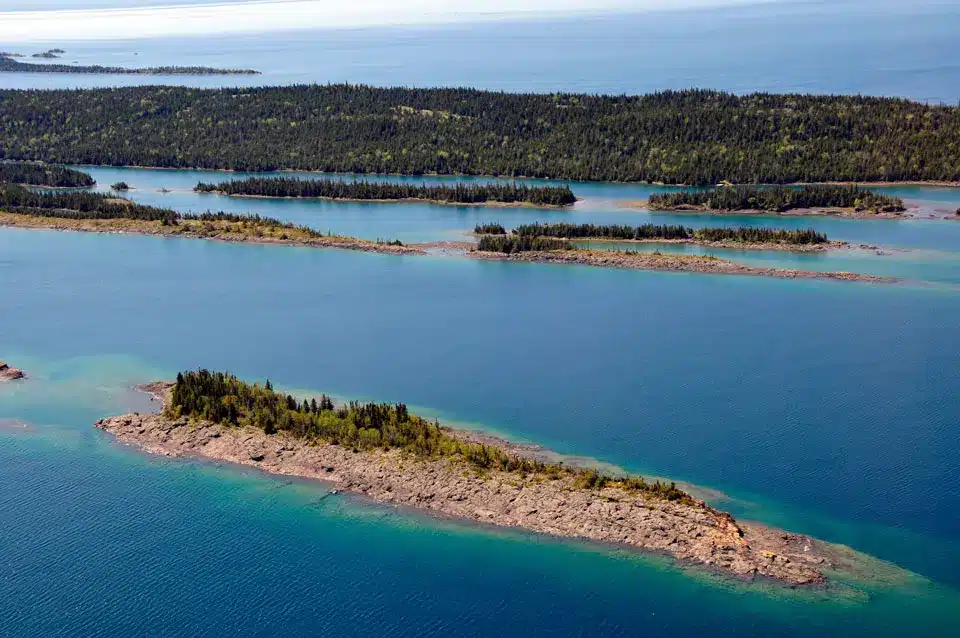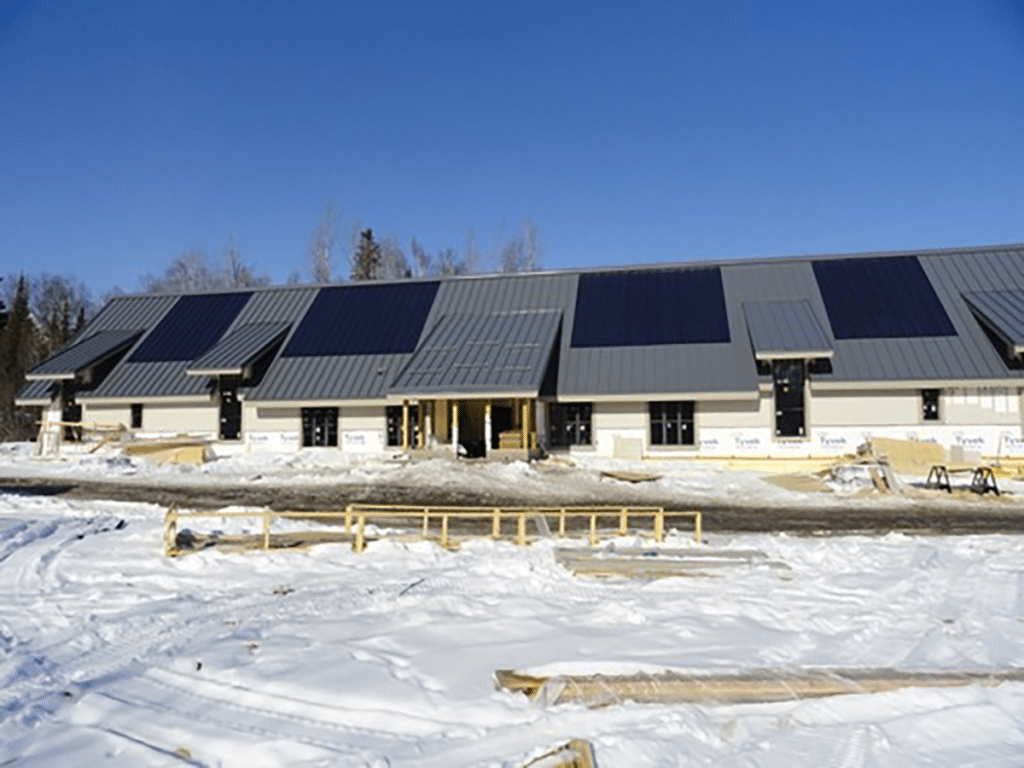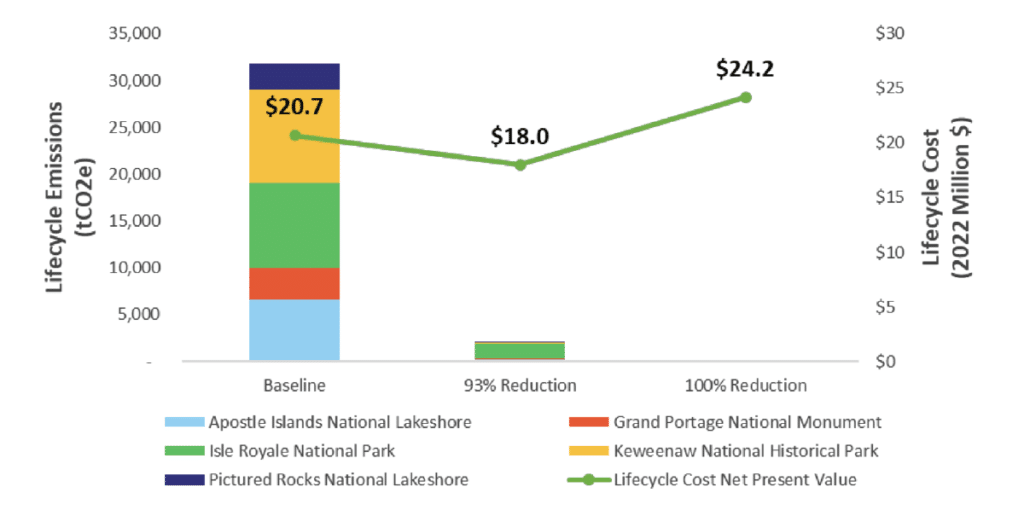
Five national parks on Lake Superior have executed long-term, sustainable options against carbon emissions. Recently, the National Parks of Lake Superior Foundation (NPLSF), in partnership with the National Park Service (NPS) took bold steps against climate issues. Grand Portage National Monument and Isle Royale National Park are two of the locations implementing changes.
Decarbonizing the parks
The plan includes an “ambitious project to cut carbon pollution from [national] park facilities and pursue net-zero energy consumption.”
Lake Superior holds 10% of the world’s freshwater. Experts continue to communicate that it’s getting warmer. In response to climate change, the NPLSF was formed to spearhead decarbonizing the parks. “In January 2023 we announced a first-in-the-nation comprehensive plan to decarbonize the operations of Lake Superior’s national parks, and I am pleased to say that the parks are now beginning implementation,” said Tom Irvine, Executive Director of the National Parks of Lake Superior Foundation (NPLSF), which initiated the project with the National Park Service (NPS). These plans are expected to take place through public and private partnerships.

National Parks within the Lake Superior watershed
The foundation has identified five national parks in the Lake Superior watershed as its primary focus. These parks include Apostle Islands National Lakeshore, Grand Portage National Monument, Isle Royale National Park, Keweenaw National Historical Park, and Pictured Rocks National Lakeshore. Two of the parks are situated within the Quetico Superior region.
Grand Portage National Monument
Located in northeastern Minnesota on the shore of Lake Superior, Grand Portage was a historic center of commerce between 18th-century fur traders. It’s also an important location in the lives of the Ojibwe, Anishinaabe people. Their stories and traditions are preserved there.
Park initiatives include working to develop renewable grid options, relying on renewable energy sources, such as the sun or wind to generate electricity.
Isle Royale National Park
Situated far out into Lake Superior, this 207-square-mile island is the fourth-largest lake island in the world. Managed as a wilderness area, Isle Royale draws adventurers of all sorts, and is home to an active moose and wolf population.
In efforts towards more sustainability, Isle Royale is updating staff housing with air-source heat pumps. These systems aim to heat and cool buildings more efficiently, lowering overall costs.

Plan Objectives
The Decarbonization Plan Summary highlights four objectives. They include, “utilize industry-leading technical design. Create a realistic, practical example of climate resiliency to educate and inspire others. Elevate clean energy jobs. Build an equity and inclusion lens into all aspects of the project.”
Coordinated activities will take place to generate these changes. Clean electricity will power more equipment and employees will use fewer gas-powered tools. Buildings will have better heating and cooling systems. Measures will also include changes such as electric vehicles, solar panels, and battery energy storage. The organization does not anticipate a negative impact to park operations or accessibility.
The Green Parks Plan
The NPLFS projects will echo some of the park service’s Green Parks Plan. Starting in 2012, the NPS put together an outline to improve sustainability throughout the organization. In 2023, leaders within the parks pushed for stronger objectives for the plan.
“The Green Parks Plan is a bold vision to pursue net-zero status in America’s national parks in response to climate change, and we are pleased that NPLSF is a partner to help Lake Superior’s five national parks achieve this goal in the near term,” stated National Park Service Regional Director Bert Frost.
Some of these developments include consuming only as much energy as they produce. Another action involves reducing greenhouse gas emissions, aiming to get as close to zero emissions as possible. Parks will also strive to achieve a balance between water availability and demand. Finally, they are working on eliminating waste sent to landfills.

Project expected to save millions
The energy and economic analysis reveal that the NPLSF can achieve a 93% reduction in greenhouse gas emissions, saving millions of dollars over the next 25 years. Estimates suggest that it is possible to cut operation costs by $5.6 million. In turn, this will have a positive impact on the Quetico Superior region. Isle Royale National Park Superintendent Denice Swanke states, “Each park is moving forward based on its needs, budget, and capacity.”
As a result, the foundation hopes that by taking these steps and demonstrating success, other national parks will follow suit.
More info:
- National Park Service and National Parks of Lake Superior Foundation advance efforts to combat climate change in Lake Superior’s National Parks
- National Parks of Lake Superior Foundation
- Decarbonization Plan Summary – NPLSF
- Green Parks Plan – National Park Service

Wilderness guide and outdoorswoman Pam Wright has been exploring wild places since her youth. Remaining curious, she has navigated remote lakes in Canada by canoe, backpacked some of the highest mountains in the Sierra Nevada, and completed a thru-hike of the Superior Hiking Trail. Her professional roles include working as a wilderness guide in northern Minnesota and providing online education for outdoor enthusiasts.

